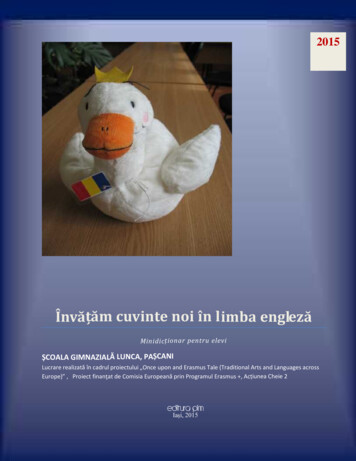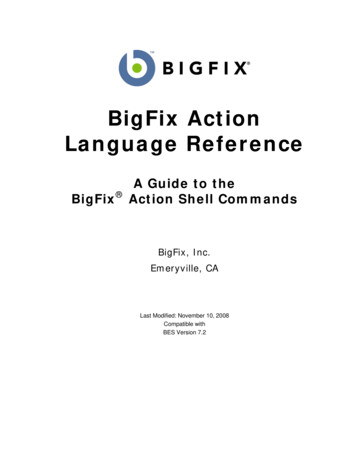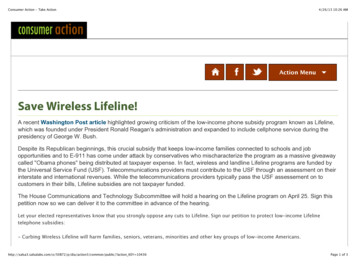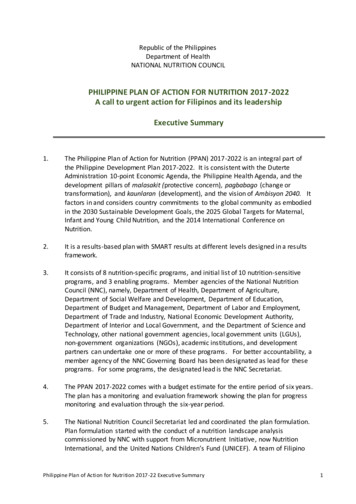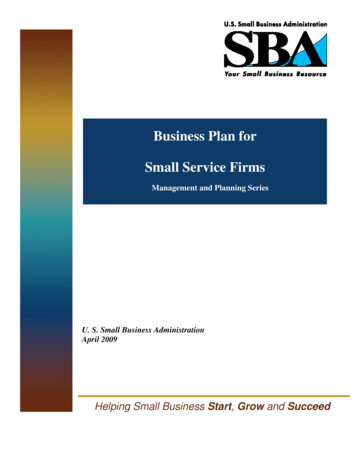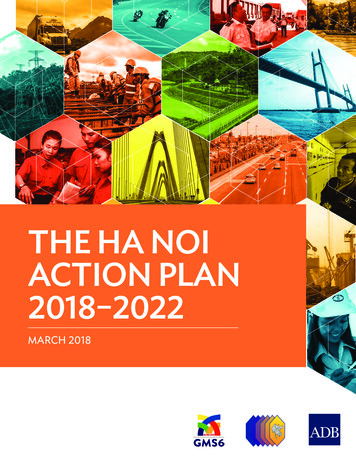
Transcription
The ha NoiacTioN PlaN2018–2022MARCH 2018
THE HA NOIACTION PLAN2018–2022mARCH 2018
Creative Commons Attribution 3.0 IGO license (CC BY 3.0 IGO) 2018 Asian Development Bank6 ADB Avenue, Mandaluyong City, 1550 Metro Manila, PhilippinesTel 63 2 632 4444; Fax 63 2 636 2444www.adb.orgSome rights reserved. Published in 2018.ISBN 978-92-9261-096-8 (print), 978-92-9261-097-5 (electronic)Publication Stock No. TCS179141DOI: http://dx.doi.org/10.22617/TCS179141The views expressed in this publication are those of the authors and do not necessarily reflect the views and policiesof the Asian Development Bank (ADB) or its Board of Governors or the governments they represent.ADB does not guarantee the accuracy of the data included in this publication and accepts no responsibility for anyconsequence of their use. The mention of specific companies or products of manufacturers does not imply that theyare endorsed or recommended by ADB in preference to others of a similar nature that are not mentioned.By making any designation of or reference to a particular territory or geographic area, or by using the term “country”in this document, ADB does not intend to make any judgments as to the legal or other status of any territory or area.This work is available under the Creative Commons Attribution 3.0 IGO license (CC BY 3.0 o/. By using the content of this publication, you agree to be boundby the terms of this license. For attribution, translations, adaptations, and permissions, please read the provisionsand terms of use at https://www.adb.org/terms-use#openaccessThis CC license does not apply to non-ADB copyright materials in this publication. If the material is attributedto another source, please contact the copyright owner or publisher of that source for permission to reproduce it.ADB cannot be held liable for any claims that arise as a result of your use of the material.Please contact pubsmarketing@adb.org if you have questions or comments with respect to content, or if you wishto obtain copyright permission for your intended use that does not fall within these terms, or for permission to usethe ADB logo.Notes:In this publication, “ ” refers to US dollars.Corrigenda to ADB publications may be found at http://www.adb.org/publications/corrigendaPhotos on the front cover:All photos are from ADB unless otherwise stated.Top row, from left: Trucks passing through Asian Highway 131 (Route 12); a view of Highway No. 12 linking the easternand western parts of Thailand; A logistics center inspection and quarantine facility in the People’s Republic of China;boats transporting tourists to Phong Nha National Park.Middle row, from left: The 1,070-megawatt Nam Theun 2 hydropower plant along the Nam Theun River in the LaoPeople’s Democratic Republic exports 95% of the power it produces to Thailand, while the rest are consumed locally;the construction of two cable-stayed bridges across the Mekong River under the Central Mekong Delta RegionConnectivity Project provide efficient access from Ho Chi Minh City to the southern coastal region; the visitors’ centerat the Nam Theun 2 hydropower plant; the Tsubasa Bridge, which opened in 2015, is along Cambodia’s National RoadNo. 1 that connects Phnom Penh to Ho Chi Minh (photo by Mardy Suong).Bottom row, from left: Sompong Visetsin (left), a cooling systems and refrigeration teacher, and her students at theChampasak Technical and Vocational Education and Training Institution; the 8.3 kilometer long Nhat Tan Bridge,also called the Viet Nam–Japan Friendship Bridge, is a cable-stayed bridge crossing the Red River; the Vo NguyenGiap Expressway that runs from Ha Noi to Noi Bai International Airport was completed on 4 January 2015; Wang Shilinis checking power generation operations in a plant in the People’s Republic of China; the Bo Aung Kyaw Port is animportant entry point for goods into Yangon; young women engineers at a construction site in Naypyidaw, Myanmar.Printed on recycled paper
CONTENTSFigures, Box, and TablevAbbreviationsviExecutive SummaryviiiI. Introduction1II. The Greater Mekong Subregion Strategic Framework 2012–2022:An OverviewA. Goals and Strategic DirectionsB. The Regional Investment Framework334III. The Midterm Review of the Greater Mekong SubregionStrategic Framework 2012–20227A. Objectives7B. Major Findings71. Relevance of the Greater Mekong Subregion Economic CooperationProgram Strategic Framework 2012–2022 (GMS SF-II) to the NationalDevelopment Agenda72. Alignment of the Overall Greater Mekong Subregion Economic CooperationProgram Strategic Framework 2012–2022 (GMS SF-II) Strategy, SectorStrategies, and Regional Investment Framework Projects73. Implementation Performance84. Planning and Programming Processes125. Institutional Performance13C. Midterm Review Conclusions, Recommendations, and Way Forward17Iv. Regional and Global Developments and Challenges21v. The Ha Noi Action Plan 2018–2022A. Guiding FrameworkB. A Spatial Strategy Focused on Economic CorridorsC. Refinements in Sector Strategies and Priorities1. Transport2. Urban Development, Border Economic Zones, and Other MultisectorSpatial Projects232324252527iii
ivContents3. Energy4. Agriculture5. Environment6. Tourism7. Trade Facilitation8. Human Resource Development9. Information and Communication TechnologyD. Improvements in the Planning, Programming, and Monitoring Systemsand ProcessesE. Enhancements in Institutional Arrangements and PartnershipsF. Ensuring the Successful Delivery of the Ha Noi Action Plan 2018–2022Appendix: The Ha Noi Action Plan 2018–2022—Sector Operational Priorities2829313234343536373841
FIGURES, BOX, AND TABLEFigures1The Greater Mekong Subregion Regional Investment FrameworkBusiness Processes2The Ha Noi Action Plan Guiding Framework3Vision and Operational Priorities of Transport Sector Strategies I and II4Key Features of the Urban Development Strategic Framework5Stages in Establishing the Greater Mekong Subregion Power Market6Key Features of Agriculture Strategies in the Greater Mekong Subregion7Core Environment Program Strategic Shifts8Refinements in Tourism Strategies in the Greater Mekong Subregion9Key Features of the Strategic Framework and Action Plan for Human ResourceDevelopment in the Greater Mekong Subregion 2013–201710The Ha Noi Action Plan EnablersBoxTableGoals of the Greater Mekong Subregion Strategic FrameworkThe Ha Noi Action Plan 2018–2022—Sector Operational Priorities5232627293031333538341v
ABBREvIATIONSviADBAsian Development BankASEANAssociation of Southeast Asian NationsCBTACross-border Transport Facilitation AgreementCEPCore Environment ProgramCEP SFAPCore Environment Program Strategic Framework and Action PlanECFEconomic Corridors ForumEWECEast–West Economic CorridorGMSGreater Mekong SubregionGMS-SFGreater Mekong Subregion Strategic FrameworkHAPHa Noi Action PlanHRDhuman resource developmentICTinformation and communication technologyLao PDRLao People’s Democratic RepublicMTCOMekong Tourism Coordinating OfficeMTRmidterm reviewNSECNorth–South Economic CorridorPRCPeople’s Republic of ChinaRCIregional cooperation and integrationRIFRegional Investment FrameworkRIF-IPRegional Investment Framework–Implementation PlanRKCRevised Kyoto ConventionRPTregional power tradeSASRAPStrategy for Promoting Safe and Environment-Friendly Agro-based Value Chainsin the Greater Mekong Subregion and Siem Reap Action PlanSEAPsafe and environment-friendly agriculture productsSECSouthern Economic CorridorSEZsSpecial Economic ZonesSFAPStrategic Framework and Action PlanSMEssmall and medium enterprises
AbbreviationsSOMSenior Officials MeetingSPSsanitary and phyto-sanitary standardsTAtechnical assistanceTFWGTrade Facilitation Working GroupTrSSTransport Sector StrategyTSSTourism Sector StrategyTTFtransport and trade facilitationUDSFUrban Development Strategic Frameworkvii
EXECUTIvE SUmmARYThe Ha Noi Action Plan 2018–2022 (HAP) reflects the Greater Mekong Subregion(GMS) Program’s agenda for the remaining 5 years of the GMS EconomicCooperation Program Strategic Framework 2012–2022 (GMS SF-II). The GMSSF-II was endorsed at the 17th GMS Ministerial Conference in August 2011 and adoptedat the 4th GMS Summit in the same year. The conduct of a midterm review (MTR) ofGMS SF-II was endorsed by the 21st Ministerial Conference in December 2016 with theobjectives of (i) assessing the progress made so far and the work that remains to be done;(ii) determining the GMS Program’s continued effectiveness and responsiveness based onthe GMS countries’ development needs and priorities; and (iii) identifying the emergingthrusts at the program and sector levels.The MTR focused on five assessment areas with the following key findings: viiiContinued relevance of the GmS SF-II in supporting national priorities.The GMS SF-II remains relevant and responsive to the GMS countries’development agenda. Transport and economic corridor development wereconsidered by the GMS countries to be the most beneficial areas of cooperation,as these directly support their industrialization, economic diversification, andvalue chain integration strategies.Consistency between sector strategies and overall GmS Program strategy.On the whole, the overall GMS SF-II strategies and sector strategies are aligned,i.e., they are positioned relative to each other toward achieving the same goals.A review of the project portfolio, however, indicates that some sector prioritieswere supported more strongly than others.Implementation performance. The implementation performance across sectorswas mixed. The strong sector performers were transport, tourism, agriculture,and environment. The energy and trade facilitation sectors made incremental butslow progress. Urban development is still at the initial stages of operationalizingits strategic framework. The human resource development sector recently wentthrough a process of rationalizing cooperation modalities in its four subsectors.Cooperation in information and communication technology (ICT) has notprogressed in the absence of an updated strategy, although the private sector-lede-commerce platform has reported some results.Planning and programming processes. The GMS Program does not have a welldefined planning and programming process. The timeframes of sector strategiesvary; goals are not defined in measureable terms; and results monitoring has notbeen fully developed and operationalized. The Regional Investment Framework(RIF)—the planning framework for project identification and prioritization—has
Executive Summary had limited effectiveness because of its limited project coverage (i.e., mostlyprojects funded by the Asian Development Bank [ADB]). Prioritization criteriahas focused mainly on financing availability, and undercounting of projects occursin some sectors.Institutional performance. The GMS institutional mechanisms remain effectiveand have been responsive to the demands of delivering on sector goals.Specialized bodies have been formed at the sector level (e.g., Greater MekongRailway Association, Regional Power Trade Coordination Center, Mekong TourismCoordinating Office). New working groups have been established in health andurban development (replacing the Urban Task Force which initially served as aplatform to exchange information and upgraded to a working group tasked todevelop and implement the urban strategic framework). Beyond participationin GMS meetings, the private sector has been engaged in concrete initiatives.There is encouraging evidence of partnerships with stakeholders, including withcommunity-based groups, occurring at the project level. ADB’s role as leadfinancier and central secretariat has been cited as one of the core strengths of theGMS Program.The MTR concluded that the strategic thrusts of GMS SF-II remain relevant, and themember countries recognize the value-addition of the GMS Program. However, the rapidlyevolving regional and global landscapes require the GMS Program to reposition and refineitself to be more effective.Based on the recommendations of the MTR, the Ha Noi Action Plan (HAP) 2018–2022was prepared and discussed at the 22nd GMS Ministerial Conference in Viet Nam on20 September 2017. The HAP provides the directions and operational focus for theremaining 5 years of the GMS SF-II. It lays down both the unfinished and expanded agendafor the medium term. The HAP also guides the RIF, which identifies the pipeline of GMSprojects. The HAP has four key elements:(i) A spatial strategy focused on economic corridors. GMS economic corridorsare considered as a network, instead of as independent individual corridors.Multisector area plans for priority areas along the corridors (clusters of urbanareas and border areas) will be prepared. There will be a better balance of externalconnectivity with domestic connectivity to foster a more equitable distribution ofthe benefits of growth.(ii) Refinements in sector strategies and operational priorities. These aresummarized below:(a) Transport: Promote intermodal links, transport facilitation, logisticsdevelopment, road safety, and asset management.(b) Urban development: Focus on urban systems as part of spatial planning on aGMS wide basis, linking urban areas.(c) Energy: Power market integration remains a priority and focus will be ongrid-to-grid power trade between any two countries and later throughtransmission lines of third countries.(d) Agriculture: Promote the value-chain approach to safe and environmentfriendly agriculture products.ix
xExecutive Summary(e) Environment: Pursue ecosystem-based service approach to landscapes in theGMS Program and the RIF, and in international frameworks.(f) Tourism: Improve quality and visitor experience, develop secondary tourismdestinations, and develop human resources through competency-basedtraining linked to standards of the Association of Southeast Asian Nations.(g) Trade facilitation: Prioritize customs modernization, coordinated bordermanagement, and risk-based approaches to sanitary and phyto-sanitarystandards.(h) Human resource development: Focus on subregional health issuesand engage other development partners in labor and migration, socialdevelopment, and technical and vocational training.(i) Information and communication technology: Promote ICT applications,address digital divides, and foster ICT innovations.(iii) Improvements in planning, programming, and monitoring systems and processes.These include:(a) developing guidelines for sector plans and strategies;(b) identifying quantitative goals and developing results monitoring framework;(c) improving the RIF coverage, principles, and processes to ensure that GMSprojects support HAP priorities, and that the RIF includes projects by GMSgovernments, ADB, and development partners; and(d) pursuing a more systematic approach to resource mobilization.(iv) Enhancements in institutional arrangements and partnerships. These cover:(a) empowering national secretariats to take greater responsibility incoordinating the GMS Program;(b) designating a country lead or coordinator for sector working groups, andallowing flexible institutional arrangements outside of the formal structures(ad hoc experts groups, networking, peer exchanges); and(c) strengthening the role of the Senior Officials Meeting as an oversight andcoordination body for the working groups.In terms of partnerships, the private sector will be encouraged to participate in the sectorworking groups in specific initiatives (e.g., investments in supply chains, special economiczones, and industrial parks, and in public–private partnership schemes in health andeducation); as well as increase collaboration with local governments and local communities.Several factors will determine successful delivery of results under the HAP. These factorsmust be consciously harnessed, managed, and mainstreamed into the process of executingthe HAP so that they become “enablers” for goal attainment. These “enablers” include(i) generating synergies with the Association of Southeast Asian Nations and otherregional initiatives, (ii) effective private sector engagement, (iii) innovative approachesto project design and institutional arrangements, (iv) technology-enabled processes,and (v) knowledge linkages and use.
I. INTRODUCTIONTwenty-five years of cooperation under the Greater Mekong Subregion (GMS) Programhave witnessed the evolving cooperation and partnership among the six countries thatshare the Mekong River. In 1992, Cambodia, the People’s Republic of China (PRC),the Lao People’s Democratic Republic (Lao PDR), Myanmar, Thailand, and Viet Namestablished the GMS Economic Cooperation Program and requested the AsianDevelopment Bank (ADB) for support. It was not until 2002 that the Building on Success:A Strategic Framework for the Next Ten Years of the Greater Mekong Subregion EconomicCooperation Program (GMS SF-I) was adopted covering the period 2002–2012. It wassucceeded by the Greater Mekong Subregion Economic Cooperation Program StrategicFramework 2012–2022 (GMS SF-II), for which a midterm review (MTR) has beenconducted. This Ha Noi Action Plan 2018–2022 (HAP) reflects the GMS Program’s agendafor the remaining 5 years of GMS SF-II based on the findings of the MTR, as well as thenew thrusts and operational priorities of sector strategies. It builds on past achievementsand lessons learned, and charts the way forward to address the emerging developmentchallenges through regional cooperation.1
II. THE GREATER mEkONG SUBREGIONSTRATEGIC FRAmEwORk 2012–2022:AN OvERvIEwA. Goals and Strategic DirectionsThe Greater Mekong Subregion Economic Cooperation Program Strategic Framework2012–2022 (GMS SF-II) was endorsed at the 17th GMS Ministerial Conference inAugust 2011 and adopted at the 4th GMS Summit in the same year. It succeeded Buildingon Success: A Strategic Framework for the Next Ten Years of the Greater MekongSubregion Economic Cooperation Program (GMS SF-I), which came 10 years after theestablishment of the GMS Program in 1992. The GMS SF-I marked the growing complexityof the GMS Program as it ventured into more challenging areas compared to the morecautious approach during the GMS Program’s first 10 years. When the GMS SF-II wasformulated, the momentum for economic integration among the Association of SoutheastAsian Nations (ASEAN) was at its height, providing impetus for the GMS countries toaccelerate trade and investment liberalization, and take advantage of opportunities in anexpanding regional market. Market connectivity was paramount as GMS countries focusedon linking with Asia’s most vibrant economies through regional cooperation.The GMS SF-II reaffirmed the relevance of the vision and goals of GMS SF-I (Box), andcommitted to build on the progress made in previous years to bring cooperation to the nextlevel. To do this, the following six-pronged approach would be pursued:(i) greater focus on software to complement the continued focus on hardware;(ii) greater selectivity and prioritization of focus areas within sectors, including agreater focus on issues that are clearly regional in nature;(iii) closer link to the broader regional integration agenda, leading to more clarity onwhich regional issues should be covered by the GMS Program and which ones arebetter left to other regional organizations;Box: Goals of the Greater Mekong Subregion Strategic Framework Strengthen infrastructure linkagesFacilitate cross-border trade and investment, and tourismEnhance private sector participation and competitivenessDevelop human resourcesProtect the environment and promote sustainable use of shared natural resourcesSource: ADB. 2002. Building on Success: A Strategic Framework for the Next Ten Years of theGreater Mekong Subregion Economic Cooperation Program. Manila.3
4The Ha Noi Action Plan 2018–2022(iv) more attention on the linkages across different sectors;(v) rebalancing resources without changing the broad sector focus of the programa
the construction of two cable-stayed bridges across the Mekong River under the Central Mekong Delta Region Connectivity Project provide efficient access from Ho Chi Minh City to the southern coastal region; the visitors’ center at the Nam Theun 2 hydropower plant; the Tsubasa Bridge
